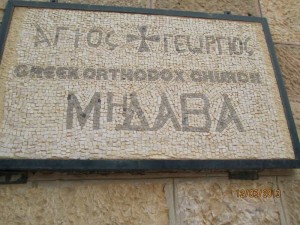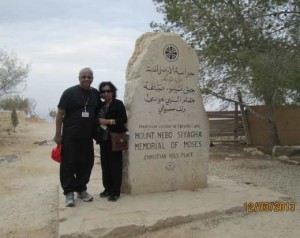We flew from Cochin to Amman, Jordan.
There was nothing remarkable or striking about Amman. It is essentially desert – probably akin to areas like Los Angeles and Las Vegas many decades ago before development occurred and sources of water were either found or redirected to those cities.
Jordan is primarily Muslim but Christians live peacefully with Muslims and there is no tension between the groups – they socialize, work together and are respectful of the respective traditions and beliefs of the other group. Jordan also has a tradition of receiving refugees from other parts of the Middle East at times of upheaval in those regions. In the 70s’ there were refugees from the West Bank after the ‘67 Arab-Israel war. In subsequent years there have been refugees from Iraq, Lebanon, Egypt and more recently from Syria. It has imposed tremendous strains on the social fabric as well as the economy of Jordan in the process. Most of the refugees are housed in tents and although the UN, the US and some other countries offer aid to help with the refugee problem the brunt of the cost is still borne by Jordan both financially as well as in its impact on the Jordanian people.
Our Jordanian guide had moved there from Dearborn, Michigan two years earlier because his aging parents needed help
and he felt it was his duty to help them. He said that it was difficult for his family to adjust to life in Jordan after living in the US especially given his reduced income in relation to the cost of living.The topography is interesting in that buildings in Amman are on multiple levels as there are a lot of hills – barren of any vegetation for the most part – but houses and apartments have been built at different levels with some having panoramic views of the city. The buildings make for a sea of white or off white because they are all constructed with Jordanian limestone.
Jordan is basically a poor country with little in the way of resources and there is a marked disparity between the rich and poor who make up the bulk of the population. Unlike other Arab countries that have oil, Jordan does not have any oil or any other natural resources. According to the guide much of the real estate in Amman is owned by approximately 150 families. The rest of the population rents from these families who are their landlords.
There are two major biblical attractions we were shown: first there was the St George Greek Orthodox church in Madaba.  The significance of the church is that during its construction in the 18th century a mosaic map was found that dates back centuries. Unearthed 1864, the mosaic was once a clear map with 157 captions (in Greek) of all major biblical sites from Lebanon to Egypt. The mosaic dates back to AD 560 & once contained more than 2 million pieces, only 1/3 of the whole now survives. What is left of this mosaic map sits in the middle of the church and is cordoned off but can be viewed.
The significance of the church is that during its construction in the 18th century a mosaic map was found that dates back centuries. Unearthed 1864, the mosaic was once a clear map with 157 captions (in Greek) of all major biblical sites from Lebanon to Egypt. The mosaic dates back to AD 560 & once contained more than 2 million pieces, only 1/3 of the whole now survives. What is left of this mosaic map sits in the middle of the church and is cordoned off but can be viewed.
The map depicts hills and valleys, villages and towns in Palestine and the Nile Delta.
The mosaic contains the earliest representation of Byzantine Jerusalem, labeled the “Holy City.” The map depicts some famous Old City structures such as the Damascus Gate, St. Steven’s Gate, the Golden Gate, the gate leading to Mount Zion, the Citadel (Tower of David) and the Church of the Holy Sepulchre. The map provides important details as to its 6th century landmarks, with the cardo, or central colonnaded street and the Holy Sepulchre clear visible. It has been an important source in developing knowledge about the physical layout of Jerusalem after its destruction and rebuilding in AD 70.The other major attraction we were shown was Mount Nebo where Moses was shown the Promised Land which he was never to enter.
The Bible says:
“Then Moses climbed Mount Nebo from the plains of Moab to the top of Pisgah, across from Jericho. There the Lord showed him the whole land…. Then the Lord said to him, “This is the land I promised on oath to Abraham, Isaac and Jacob when I said, ‘I will give it to your descendents.’ I have let you see it with your eyes, but you will not cross over into it.”
 There is a monument – supposedly his burial site – though the guide said this was merely symbolic because no one knows where he was actually buried.
There is a monument – supposedly his burial site – though the guide said this was merely symbolic because no one knows where he was actually buried.
As an aside, an Asian tourist from another group overheard our guide state that his burial site is not known and she angrily interjected that the reason there is no known burial place is because Moses was never buried – he ascended into heaven the way that Jesus Christ did which is why there is no known or purported burial place for Jesus either. She claimed that it said so in the bible. This prompted me to check it out and our guide was correct. The bible, according to Deutronomy, says:
“So Moses the servant of the LORD died there in the land of Moab, according to the word of the LORD. And he buried him in a valley in the land of Moab, over against Bethpeor: but no man knoweth of his sepulchre unto this day.”
So I am not sure where the woman was getting her information!
Tags: greek orthodox church in madaba jordan, jordan a haven for refugees, memorial to moses on mount nebo, mosaic map found in madaba jordan, view of the promised land from mount nebo, where moses was buried








Very interesting and descriptive. The excerpts about modern day Jordan were a revelation, with what seems to tantamount to a feudal system. There is a lot of lore/tradition which is tied up into Biblical history, and when maps like the mosaic one that was discovered in the 19th century show up, its nectar to the faithful. Was also impressed by your guide who left life in the United States to help out his family.
Agree with Peter A – interesting and detailed information about your visit to Jordan.
Also, good on you Rana A for fact-checking about Moses’ burial!